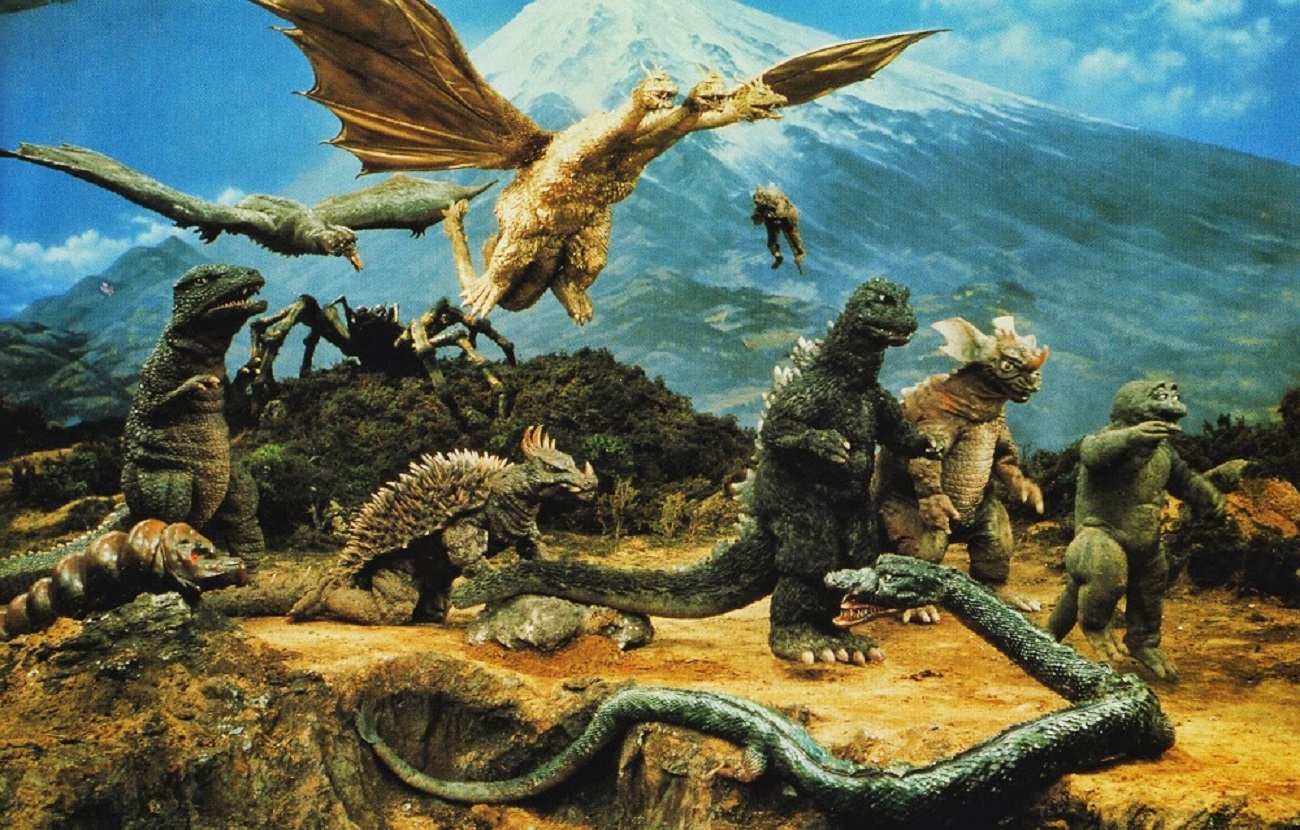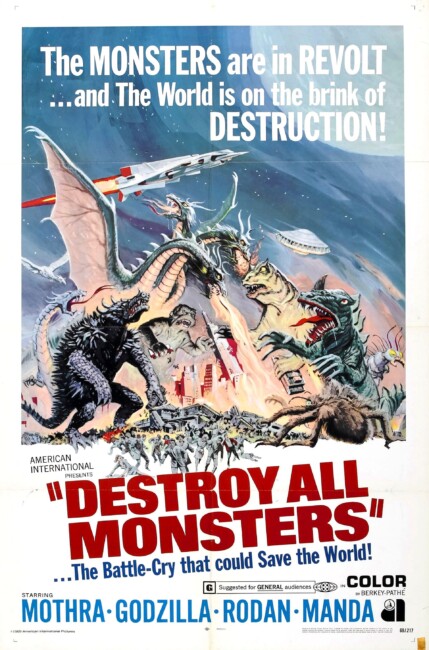(Kaiju Soshingeki)
Crew
Director – Ishiro Honda, Screenplay – Ishiro Honda & Kaoru Mabuchi, Photography – Taichi Kankura, Music – Akira Ifukube, Special Effects Director – Sanemasa Arikawa, Special Effects Supervisor – Eiji Tsuburaya, Art Direction – Takeo Kita. Production Company – Toho.
Cast
Akira Kubo (Captain Yamabe), Yukiko Kobayashi (Kyoko Minabe), Jun Tazaki (Dr Yoshida), Yoshio Tsuchiya (Dr Atsani), Kyoko Ai (Kilaak Queen), Chotaro Tohin (Ogata)
Plot
In 1999, all giant monsters have been penned in a special area on Ogasawara Island called Monsterland. Suddenly, Godzilla, Anguiras, Rodan, Mothra, Barugon, Varan, Manda, Spiga and later Ghidrah turn on humanity and start destroying cities all around the world. The crew of the moon rocket SY3 are diverted to deal with the menace and discover that they are dealing with an alien race The Kilaaks who are using the monsters to subjugate humanity and make Earth ready for invasion.
Destroy All Monsters was the 20th monster move from Toho, their ninth featuring Godzilla. To celebrate the occasion, Toho brought back just about every monster they had created before, including Mothra, Rodan, Varan, Ghidrah, Baragon from Frankenstein Conquers the World (1966), Manda from Atragon (1963), Anguiras from Gigantis the Fire Monster (1955), Gorasaurus who Kong battled in King Kong Escapes (1967) and Kumonga the spider from Son of Godzilla (1968).
Destroy All Monsters came out at a time when Toho, as well as their competitor in the monster movie market Toei, had exhausted most of the possibilities of straight monster bashes. Like Universal Studios before them in the 1940s with Frankenstein, Dracula and the Wolf Man, they then ventured into pitting their in-house monsters against one another. Beginning with Ghidrah the Three-Headed Monster (1964), which featured alien invaders wielding monsters against Japan, they attempted to combine monster movies with the popular space opera genre they had also created. The combination of monster movie and space opera became popular throughout a number of Japanese monster movies of the 1960s and 70s and is used here.

In fact, the space opera aspect is allowed to take over a substantial part the film, leaving Destroy All Monsters feeling like more of a space opera than it is ever a monster movie. The exploits of the Moon rocket expedition and the aliens taking people over gets far more time than the monsters do, for instance. The monster scenes are brief and there is little in the way of mass destruction set-pieces that make these films so much fun. Nor is their any clear good guy monster defender.
The plot is simplistic and considerably wrecked by bad dubbing. The show does rise to the occasion at the climax where it finally engages in one of the wonderfully colourful and silly tag team wrestling matches that makes these films so much fun, with the other monsters all beating up on Ghidrah. Certainly, in terms of the landmark film it was intended as though, Destroy All Monsters is underwhelming.
The other Godzilla films are:– Godzilla, King of the Monsters (1954), Gigantis the Fire Monster/Godzilla Raids Again/The Return of Godzilla (1955), King Kong Vs. Godzilla (1962), Godzilla vs the Thing/Mothra vs Godzilla (1964), Ghidrah the Three-Headed Monster (1964), Monster Zero/Invasion of the Astro Monster (1965), Godzilla vs the Sea Monster/Ebirah, Horror of the Deep (1966), Son of Godzilla (1968), Godzilla’s Revenge (1969), Godzilla vs the Smog Monster/Godzilla vs Hedorah (1971), Godzilla vs Gigan/Godzilla on Monster Island (1972), Godzilla vs Megalon (1973), Godzilla vs the Cosmic Monster/Godzilla vs the Bionic Monster/Godzilla vs Mechagodzilla (1974), Terror of Mechagodzilla/Monsters from an Unknown Planet (1976), Godzilla 1985 (1984), Godzilla vs. Biollante (1989), Godzilla vs King Ghidorah (1991), Godzilla and Mothra: The Battle for Earth (1992), Godzilla vs Mechagodzilla (1993), Godzilla vs Space Godzilla (1994), Godzilla vs Destoroyah (1995), Godzilla 2000 (1999), Godzilla vs Megaguirus (2000), Godzilla Mothra and King Ghidorah: Giant Monsters All-Out Attack (2001), Godzilla Against Mechagodzilla (2002), Godzilla: Tokyo SOS (2003), Godzilla: Final Wars (2004), Shin Godzilla/Godzilla: Resurgence (2016) and Godzilla Minus One (2023), plus the anime Godzilla: Planet of the Monsters (2017), Godzilla: City on the Edge of Battle (2018) and Godzilla: The Planet Eater (2018). Both Roland Emmerich’s Godzilla (1998) and Gareth Edwards’ Godzilla (2014) are big-budget, English-language remakes, while the latter launched three sequels with Godzilla, King of the Monsters (2019), Godzilla vs. Kong (2021) and Godzilla x Kong: The New Empire (2024).
Trailer here


